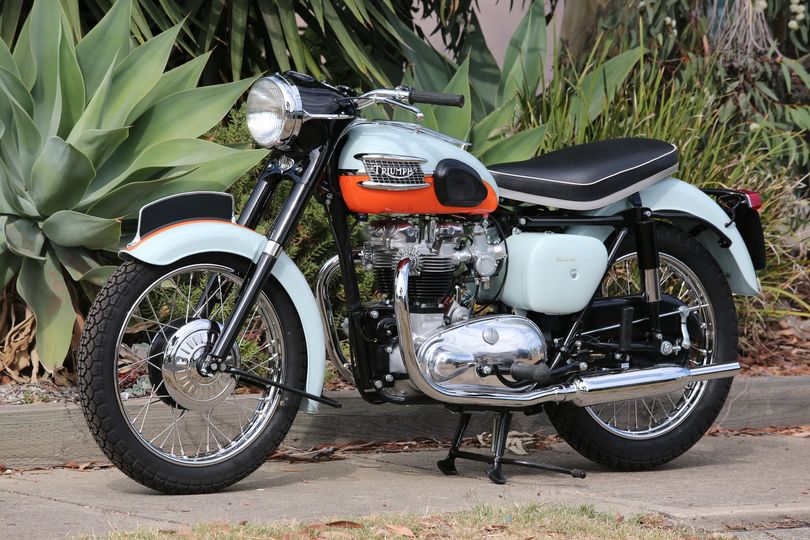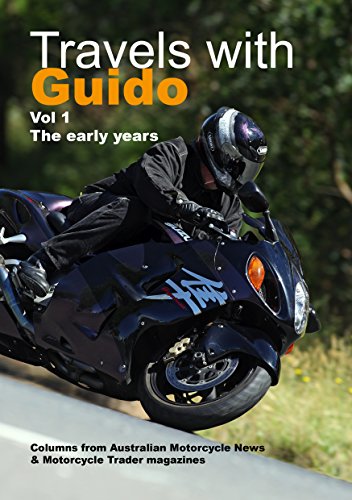Motorcycle Investor mag
Subscribe to our free email news

Speed dreams
(by Ian Falloon, Mar 2022)

Triumph's
first Bonneville got off to a surprisingly rocky start
On a bright morning in September 1956,
Texan Johnny Allen
arrived at the Bonneville Salt Flats in Utah. The
diminutive Allen slid into
the cockpit of a streamlined two-wheeler, nicknamed the
Texas Ceegar.
Inspired by the fuel ‘drop tanks’ of a
Mustang fighter plane
this amalgamation of American and British expertise
carried a Texas star on its
nose, and the Triumph name on its side.
With power supplied by a
nitro-methane-fed 650cc Thunderbird
parallel twin, the cigar-shaped streamliner tore across
the salt flats at an
average of 214.40mph (345.188 km/h). Although this was
clearly a new world
record the FIM world body didn’t recognise it as the US
AMA at that time.
Triumph boss Edward Turner was
unperturbed. He had the Texas
Ceegar air freighted to the Meriden factory in England,
first to appear in a
BBC TV sports program, then for display on the Triumph
stand at the annual
London Earls Court Motorcycle Show.
All this publicity fuelled the demand for
a higher performance
version of the production T110 650cc twin. But Turner’s
distrust of racing as a
promotional tool was well known and initially the
company’s policy was
unchanged.
Rather than provide a higher performance
model Triumph initially
offered a limited number of higher performance
components for purchase. This
included pistons, valves, camshafts, valve springs and a
megaphone exhaust. The
release of a splayed port “Delta” twin carburettor
cylinder head for the 500cc
Tiger T100 in 1957 also saw demand for a 650cc version,
particularly from
American customers.
For 1958 Triumph finally offered a twin
carburettor 650cc
splayed inlet port cylinder head as an optional
replacement for the T110. This
provided the T110 the performance and reliability it
finally needed to win the
important Thruxton 500 production race, with a young
Mike Hailwood teaming with
Dan Shorey for the win.
The twin carb heads were also successful
in America, Triumphs took
eight of the first 10 places in the 1958 Big Bear Run
Desert Enduro.
While motorcycle sales were still strong
in the UK, at this time
Triumph was also the most popular imported motorcycle in
America. The company
relied heavily on the US market and eventually Turner
bowed to US pressure to
build a production twin carburettor 650.
This would be the Bonneville, the
motorcycle that would define
Triumph for the next three decades and continue to do so
today. As it was
considerably more affordable than a Norton 650SS, and
faster than a BSA 650,
the Bonneville became the favoured mount for the young
British working class.
Despite some initial problems, of all the
British twins it was
the lightest, fastest and most elegant.
Along with a splayed-port cylinder head
and twin Amal
carburettors, the 650cc engine featured a high-lift
camshaft and
high-compression pistons. The crankshaft was also a
stronger one-piece forged
type with centrally bolted cast-iron flywheel.
Ostensibly a modified T110 Tiger, the
first Bonneville was a no
holds barred sportster, but the engine wasn’t without
problems. Vibration was
still a concern, and the single frame-mounted racing
type remote float bowl
carburettor proved problematic. Hard acceleration and
braking caused fuel
surging and subsequent misfiring. Triumph offered a
remedy kit later in the
season but problems persisted.
Rushing the Bonneville into production
meant it retained much of
the original T110 equipment. This included touring-type
valanced fenders and an
ungainly headlight nacelle. These not only seemed
incongruous on a
high-performance sporting motorcycle, but also didn’t
appeal to the American
market, where riders preferred the stripped-down look.
To Americans the first
Bonneville simply didn’t look right.
Also not right was the initial colour
scheme. Fancying himself
an artist, Turner presided over style and colour
combinations and back in 1957
had introduced two-tone colour schemes. These worked
well on Lambretta scooters
and some ageing British cars like the Hillman Minx, so
Turner adapted the style
for motorcycles.
For the Bonneville Turner chose a
Tangerine/Pearl Grey colour
scheme, now known as the “Tangerine Dream.” Some have
also suggested the
Bonneville’s two-colour finish was intended to suggest
the colours of the Utah
Salt Flats landscape. Regardless, these colours proved
controversial and
unpopular; many Tangerine 1959 Bonnevilles in the US
ended up unsold, and were
listed again for 1960. Ironically the 1959 Bonneville is
now viewed as a rarity
and the original colour scheme considered desirable.
It didn’t take long for Meriden to
realize the failure of the
initial colour scheme and in April 1959 the factory
changed the colours for UK
and general export machines. Royal (also known as Azure)
Blue replaced the
Tangerine, but the rest of the machine was unchanged.
These new colours would
continue for 1960.
Meriden called the Bonneville the T120 to
indicate it was
capable of 120 miles per hour, but compared with the
usual publicity fanfare it
was announced almost apologetically.
There was originally no official brochure
and Triumph almost
treated the Bonneville as an unwelcome addition to the
family. While the “120”
designation may have been illusory, the Bonneville was
still one of the fastest
motorcycles available in 1959.
Contemporary road tests saw top speeds in
the region of 185 km/h
but you had to be a brave rider to sustain an early
Bonneville at those speeds.
The early Bonneville suffered from Turner’s obsessional
cost cutting, and the
frame, unbraced swingarm, and weak brakes were stretched
to the limit.
But the late 1950s was still a good time
for Triumph. Then
riding a wave, the Bonneville legend was established at
a time of strong sales
on both sides of the Atlantic.
Dealers in America had been crying out
for a twin-carb 650
Triumph for years and it was also what the high
performance motorcycle rockers
in England wanted.
Only in Australia was the Bonneville not
as popular. Reeling
from negative publicity, motorcycling was an endangered
activity at this time
and very few early Bonnevilles were sold here.
As with many collectables, it is the
first model that has become
the most sought after. The 1959 T120 Bonneville is the
one that created the
legend.
More on Meriden
era Bonnevilles at AllMoto
More on the
speed record bikes at AMCN
-------------------------------------------------
Produced by AllMoto abn 61 400 694 722
Privacy: we do not collect cookies or any other data.

Archives
Contact





